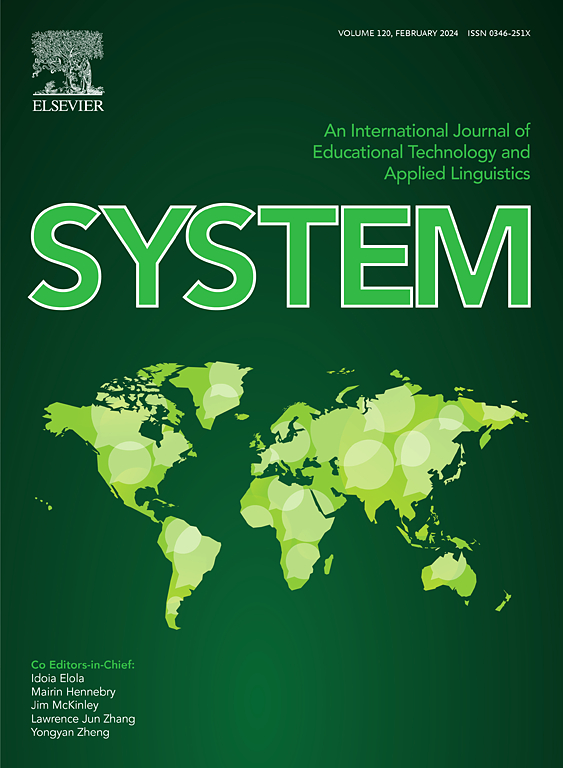Beyond monologues – Examining L2 Finnish learners’ interpersonal behavior during dialogue speaking tasks using the computer-joystick method
IF 5.6
1区 文学
Q1 EDUCATION & EDUCATIONAL RESEARCH
引用次数: 0
Abstract
Although second language (L2) speaking assessment usually seeks to cover interactional aspects, in practice, it is often limited to assessing L2 learners' individual audio-recorded performance or focusing merely on linguistic criteria. This study experiments with a new method for assessing interactional competence. The computer-joystick method allows observing both verbal and nonverbal features while rating an individual's behavior from video. The present study seeks to find out whether the method can be used to assess speakers' interpersonal behaviors reliably in the context of L2 learners' dialogue speaking tasks. The interpersonal behavior of academic L2 Finnish learners (N = 44) was examined during three spoken interaction tasks designed for A2–B2 level speakers. The study is part of a larger project which develops ways to measure and assess oral language skills automatically. Each learner's interpersonal behaviors (using two variables of dominance and affiliation, rating both linguistic and nonverbal features) were continually coded over time while watching audiovisual recordings of their speaking performance. The reliability of the ratings ranged from moderate to good. The resulting time series data were used to analyze changes in the variables and their variation according to task-level, dyad-level and participant-level predictors. Nonindependence metrics, actor and partner effects of language proficiency, and measures of synchronization between participants were investigated. In sum, it was found that the coding system can be used reliably for assessing interpersonal behaviors in the context of language assessment. Finally, potential implications for assessing spoken interaction in a second language using both humans and algorithms are discussed.
超越独白-使用电脑操纵杆方法研究第二语言芬兰语学习者在对话演讲任务中的人际行为
虽然第二语言(L2)口语评估通常试图涵盖互动方面,但在实践中,它通常仅限于评估L2学习者的个人录音表现或仅仅关注语言标准。本研究尝试了一种评估互动能力的新方法。电脑操纵杆方法允许观察语言和非语言特征,同时从视频中评价一个人的行为。本研究旨在探讨该方法是否能够在二语学习者的对话会话任务中可靠地评估说话者的人际行为。研究了学术型L2芬兰语学习者(N = 44)在为A2-B2水平的说话者设计的三个口语互动任务中的人际行为。这项研究是一个更大项目的一部分,该项目旨在开发自动测量和评估口语技能的方法。每个学习者的人际行为(使用支配和隶属两个变量,对语言和非语言特征进行评级)随着时间的推移不断编码,同时观看他们说话的视听记录。评级的可靠性范围从中等到良好。使用所得的时间序列数据分析变量的变化及其根据任务水平、双元水平和参与者水平预测因子的变化。研究了语言能力的非独立性指标、行动者和伙伴效应以及参与者之间的同步性指标。总之,我们发现编码系统可以可靠地用于语言评估情境下的人际行为评估。最后,讨论了使用人类和算法评估第二语言口语互动的潜在影响。
本文章由计算机程序翻译,如有差异,请以英文原文为准。
求助全文
约1分钟内获得全文
求助全文
来源期刊

System
Multiple-
CiteScore
8.80
自引率
8.30%
发文量
202
审稿时长
64 days
期刊介绍:
This international journal is devoted to the applications of educational technology and applied linguistics to problems of foreign language teaching and learning. Attention is paid to all languages and to problems associated with the study and teaching of English as a second or foreign language. The journal serves as a vehicle of expression for colleagues in developing countries. System prefers its contributors to provide articles which have a sound theoretical base with a visible practical application which can be generalized. The review section may take up works of a more theoretical nature to broaden the background.
 求助内容:
求助内容: 应助结果提醒方式:
应助结果提醒方式:


